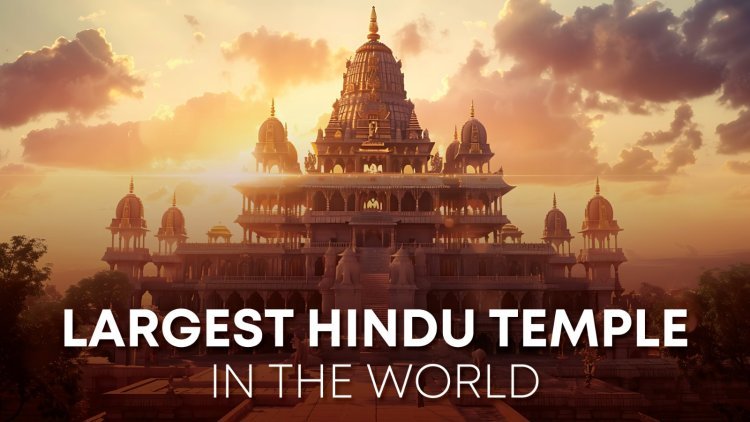Largest Hindu Temple in the World - Propacity
Temples are not merely places of worship but also architectural marvels that embody the cultural and artistic heritage of Hindu civilization. Among these, the five largest Hindu temples in the world stand out for their grandeur, architectural brilliance, and historical significance.

Hinduism, one of the world's oldest religions, has a rich tradition of temple architecture that reflects its complex mythology and philosophy. Temples are not merely places of worship but also architectural marvels that embody the cultural and artistic heritage of Hindu civilization. Among these, the five largest Hindu temples in the world stand out for their grandeur, architectural brilliance, and historical significance.
1. Angkor Wat, Cambodia
Overview: Angkor Wat, located in Siem Reap, Cambodia, is the largest religious monument in the world. Originally constructed in the early 12th century as a Hindu temple dedicated to the god Vishnu by King Suryavarman II, it later became a Buddhist temple. This vast complex spans over 162.6 hectares (1,626,000 square meters).
Architecture: The temple is an epitome of classical Khmer architecture, featuring a quincunx of towers with the central tower rising 65 meters above the ground. The temple's walls are adorned with extensive bas-reliefs and carvings depicting scenes from Hindu epics such as the Ramayana and Mahabharata.
Cultural Significance: Angkor Wat is a symbol of Cambodia and appears on its national flag. It represents the pinnacle of Khmer architecture and is a UNESCO World Heritage Site. The temple's design reflects Mount Meru, the home of the gods in Hindu cosmology, embodying the universe's structure.
2. Sri Ranganathaswamy Temple, India
Overview: Sri Ranganathaswamy Temple in Srirangam, Tamil Nadu, India, is the largest functioning Hindu temple in the world. Dedicated to Ranganatha, a reclining form of Vishnu, this temple complex covers an area of 63 hectares (631,000 square meters).
Architecture: The temple complex consists of 49 shrines, 21 towers (gopurams), 39 pavilions, and numerous water tanks. The Rajagopuram (main entrance tower) stands 73 meters tall and is among the tallest temple towers in Asia. The temple's intricate carvings and murals are masterpieces of Dravidian architecture.
Cultural Significance: Sri Ranganathaswamy Temple is an important pilgrimage site, especially for Vaishnavites. It is one of the 108 Divya Desams, the holy abodes of Vishnu described in the works of the Alvars (saint poets). The temple's annual festival, Vaikunta Ekadasi, attracts millions of devotees from around the world.
3. Akshardham Temple, India
Overview: Swaminarayan Akshardham in New Delhi, India, is one of the most modern yet grand Hindu temples. Opened in 2005 and spread over 40 hectares (400,000 square meters), it is dedicated to Bhagwan Swaminarayan and showcases the essence of India's ancient architecture, traditions, and timeless spiritual messages.
Architecture: The temple features a blend of traditional styles from across India. The main monument, constructed entirely from pink sandstone and white marble, is a visual feast with its intricate carvings, including 20,000 statues of deities, sages, and mythical figures. The central dome rises to 43 meters.
Cultural Significance: Akshardham Temple not only serves as a place of worship but also as a center for cultural and educational activities. It includes an IMAX theater, a musical fountain, and an extensive exhibition on Indian culture and spirituality. The temple complex promotes values of peace, harmony, and devotion.
4. Thillai Nataraja Temple, India
Overview: The Thillai Nataraja Temple, also known as the Chidambaram Temple, is located in Tamil Nadu, India. It is one of the holiest Shiva temples, sprawling over an area of 20 hectares (200,000 square meters).
Architecture: This ancient temple is a classic example of Dravidian architecture with its towering gopurams (gateway towers) and expansive courtyards. The temple is renowned for its gold-roofed sanctum sanctorum (Vimana), intricate stone carvings, and the Hall of Thousand Pillars. The temple complex also houses five sabhas (halls) dedicated to Shiva's cosmic dance.
Cultural Significance: Thillai Nataraja Temple is closely associated with the classical Indian dance form Bharatanatyam. It is believed to be the site where Shiva performed the Ananda Tandava, his cosmic dance of bliss. The temple is a key destination for devotees during the annual Natyanjali dance festival and the Arudra Darshan festival.
5. Meenakshi Amman Temple, India
Overview: Meenakshi Amman Temple, situated in Madurai, Tamil Nadu, India, is dedicated to Meenakshi, a form of Parvati, and her consort Sundareshwara, a form of Shiva. The temple complex covers 6 hectares (60,000 square meters).
Architecture: The temple is a masterpiece of Dravidian architecture, renowned for its 14 gopurams, the tallest of which reaches 52 meters. The intricately sculpted towers are adorned with thousands of colorful figures of deities, mythical creatures, and demons. The temple's hall of thousand pillars, Aayiram Kaal Mandapam, is a marvel of stonework with each pillar sculpted in a unique style.
Cultural Significance: Meenakshi Amman Temple is not only a spiritual center but also a cultural and historical landmark. It hosts the annual Meenakshi Tirukalyanam festival, celebrating the divine marriage of Meenakshi and Sundareshwara, which draws millions of devotees. The temple's architecture and the vibrant culture of Madurai make it a focal point for scholars and tourists alike.
Conclusion
These five largest Hindu temples in the world are more than just places of worship; they are monumental embodiments of India's rich spiritual and cultural heritage. Each temple, with its unique architectural style and historical background, offers a glimpse into the diverse traditions of Hinduism. From the ancient splendor of Angkor Wat to the modern grandeur of Akshardham, these temples continue to inspire awe and devotion, drawing millions of visitors and pilgrims from around the globe.
What's Your Reaction?










![Wireless Connectivity Software Market Size, Share | Statistics [2032]](https://handyclassified.com/uploads/images/202404/image_100x75_661f3be896033.jpg)



